How will the US dollar fluctuate in Trump 2.0 era ?
With Trump set to be inaugurated for a second time, will it be a case of cut and paste in terms of how the US dollar will trade this year?

The US dollar has rallied hard since Trump won the election on November 5th. It was the same after he won in November 2016. But, back then, something strange happened. For as soon as Trump took office, the US dollar began to slide and spent pretty much the whole of 2017 depreciating substantially.
So far, the post-election period has seen the US dollar mirror the rally we saw back in late 2016 and early 2017 between Trump’s election win and the inauguration. In fact, the US dollar has risen a little more this time around. Just as then, there’s lots of speculation that Trump will deliver policies that lift the greenback, such as tax cuts and tariffs. But if these things did not deliver US dollar strength back then, why should it be any different today?
One potential difference was that Trump did not deliver tariffs from the off in his first term. It took until 2018 for tariffs to get going and, in that year, the dollar unwound much of the previous fall. If this serves as any sort of template, it suggests that any US dollar strength based on tariffs will only accrue when the tariffs are delivered, not when they are promised. Of course, Trump did undertake much trade agitation early on in his first term, starting with an executive order to pull the US out of the Trans Pacific Partnership (TPP).
Nonetheless, it does seem that Trump had to deliver the tariffs before the US dollar rallied. Fast forward today and it does seem as if tariffs are on a more accelerated timetable than we saw during Trump’s first term. Threats of higher tariffs are already out there and, while these are unlikely to be a part of the very early policy pronouncements, it does not seem as if we will have to wait more than a year for the first tariffs, as we did when he was inaugurated in January 2017.
This is one reason why the Standard Bank has tended to keep its forecasts biased for more US dollar strength in coming weeks and months, rather than match up its dollar view to the 2017 experience. It still feels that the US dollar will give back these gains later in the year, just as we saw in 2017; it just might take a little longer this time around.
While tariffs seem central to the outlook for the US dollar, we also have to recognise that they are certainly not the only potential drivers of the US dollar, just as we have to bear in mind that we can’t really compare today to 2017 as so many things are different. This being said, these other ‘things’ include monetary policy, and the difference here is that the Fed was tightening policy quite sharply through 2017, whilst it is easing at the moment.
In this sense, there’s perhaps even more reason for the US dollar to give back its post-election strength this time around than back in 2017. We might also recognise the difference in the budgetary situation facing Trump. The debt/GDP ratio is some twenty percentage points of GDP higher today than it was when Trump came into office in 2017 and, at around 100% of GDP, there is wide recognition that it is unsustainable. This too might seem to suggest that the US dollar is more vulnerable than 2017 as the risk that foreign investors get cold feet on treasuries—and the US dollar – is greater now.
Putting all this together, the US dollar rose some 3.5% in trade-weighted (DXY) terms between the 2016 election win and inauguration, but then fall around 9% through to the end of 2017. More recently, the US dollar has risen by around 5.5% since the November 2024 election win and the Standard Bank thinks it could rise up to 5% more in the coming months. However, by the end of this year, the US dollar could go down more than 5% from current levels and 10% from the peak.








